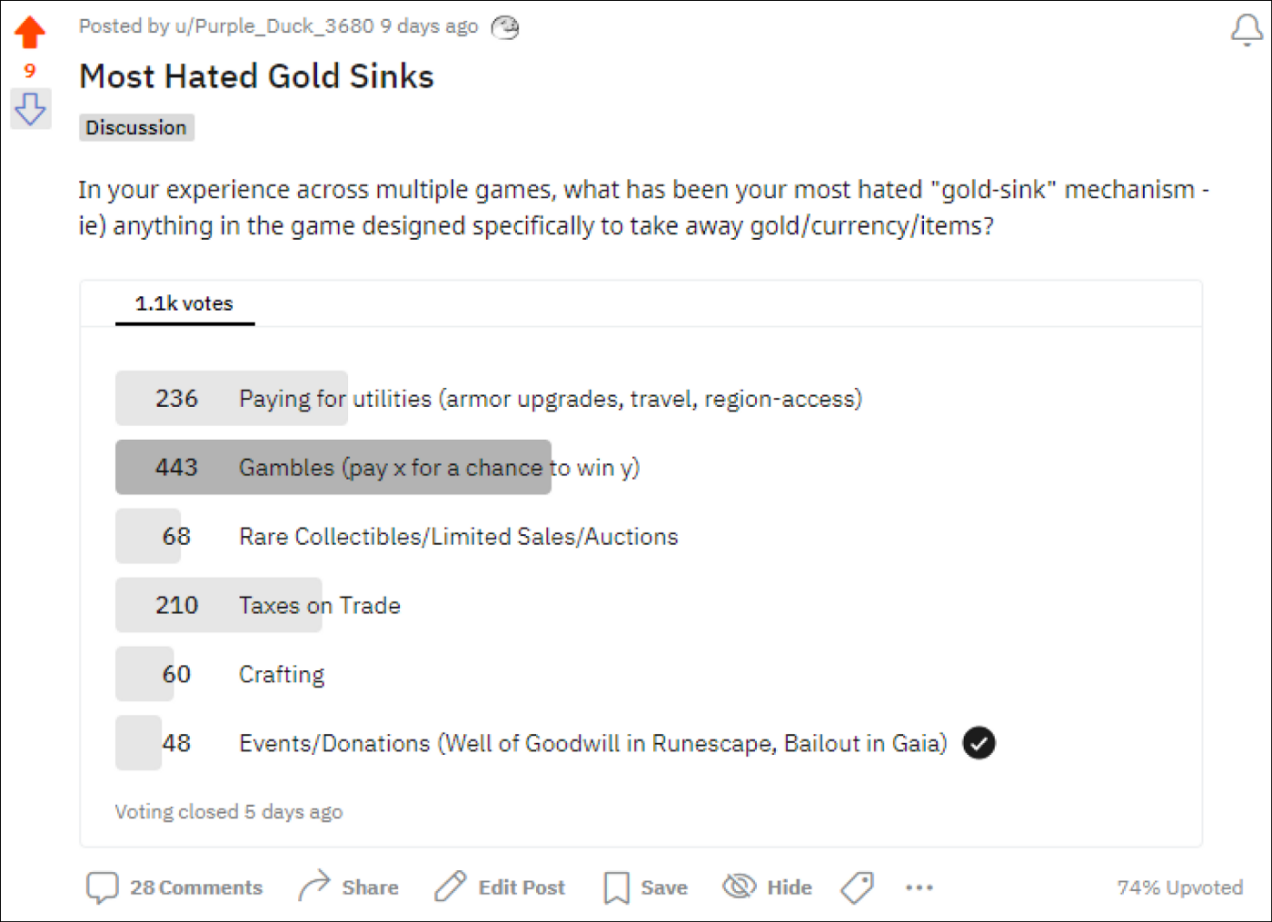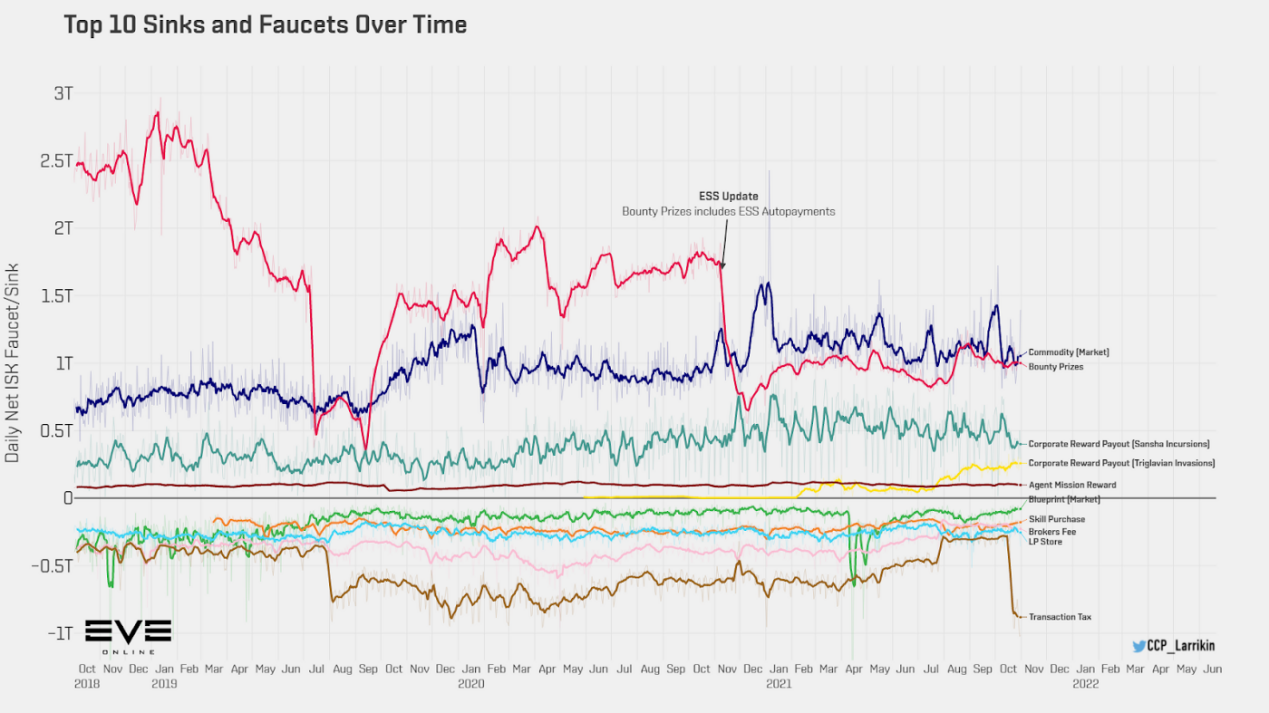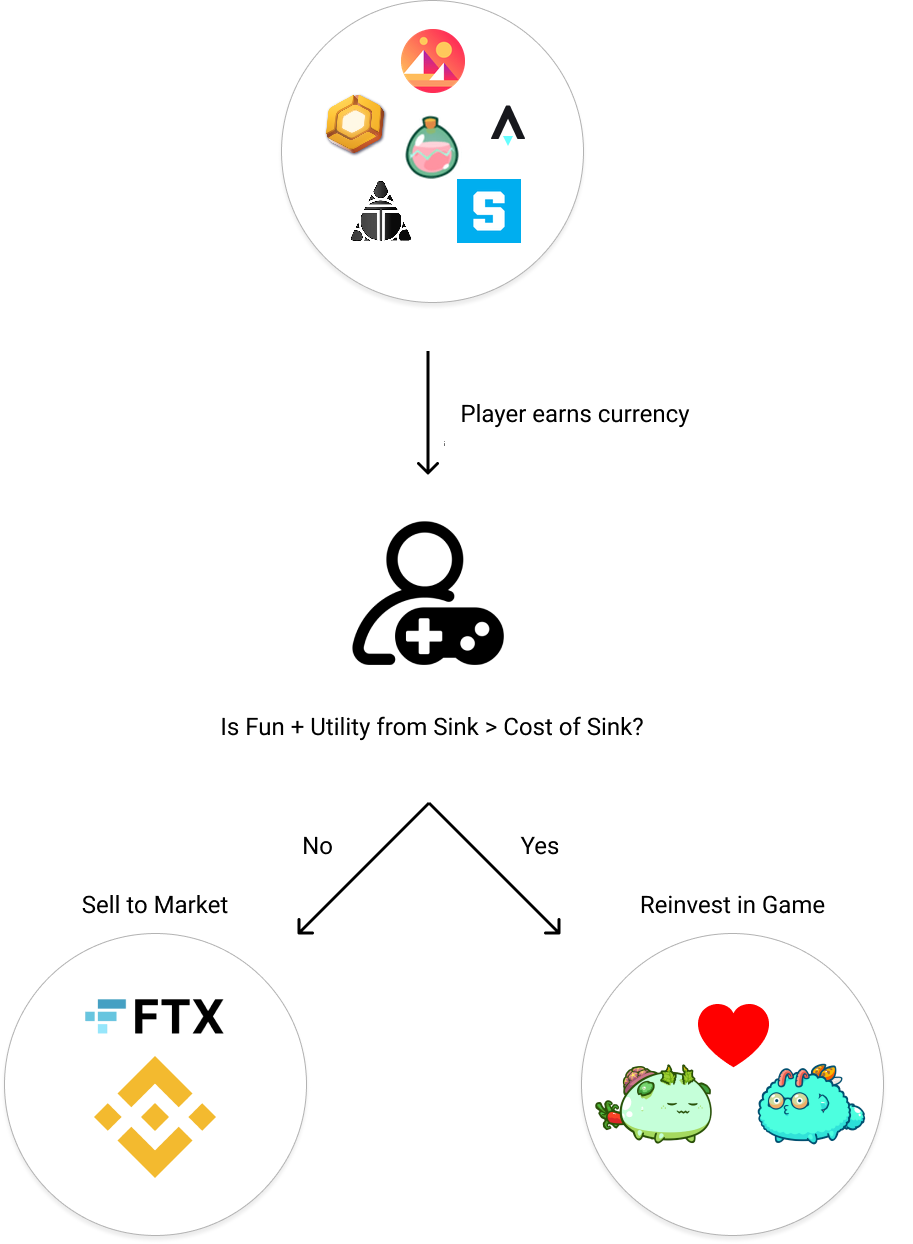Designing economic systems for games is not unique to Web3 games. How to create more revenue for game developers without destroying the game experience has always been an important issue for paid games. This article is to sort out various payment strategies of Web2 games in the past, and explore the reference and future of Web3 games.
Translator's introduction: P2E (earning while playing) games, represented by Axie Infinity , have made great strides in the past year, but at the same time, there have been disputes over the sustainability of their economic system. Most game developers and players still show resistance to this. For example, according to a recent Game Developers Conference (GDC) survey, 72% of the developers surveyed said that they and their studios are not interested in integrating encryption systems into games. not interested in.
But in fact, designing an economic system for games is not an original creation of Web3 games. How to create more income for game developers without destroying the game experience has always been an important issue for paid games. Terry Chung from 1kxnetwork published this article, which is to sort out various payment strategies of Web2 games in the past, and explore the reference and future of Web3 games.
The following is the full text translated by PAN ews :
For a virtual game economy to maintain economic balance—the relative stability of its core currency and items—it must balance the issuance rate of assets with the consumption/demand rate of assets.
That is, in and out should be basically balanced.
To do this, it has several options:
Continue to increase the speed of user pull, so that there will always be new players buying from old players.
Continuously introduce newer, harder, and more resource-intensive "final game content" (PANews Note: In RPG or MMORPG, when players reach a certain level cap, the content that can be provided to this class of players to play the game), Make existing players consume more resources.
Balance the creation of gold coins and items (tap) with the removal of the aforementioned coins and items from the game (sink).
If this balance is not maintained well, player experience and retention will suffer.
Fortunately, virtual economies have been around for decades, and there are plenty of failed experiments and hyperinflationary game precedents from which we can learn. We hope to introduce how the previous virtual economy used the "sink" to achieve the return of game currency, as well as the effects of different strategies, and user acceptance. Additionally, we'll review some of the new balancing tools available for "community and culture first" P2E games.
content
Part1: Lessons learned from previous games
1 Utilities, Rare Collectibles, and Gambling Mechanics
2 Taxation of trade and land
3 Equipment casting
4 Staking to convert high turnover cash into consumables/items
5 Unlock more game content
6 Donations/Activities
Part2: Strategies unique to Web3 games
1 Incubation MOB and fork
2 Community-based combustion mechanism
3 Build and own critical infrastructure
Summary: Conditions under which the "sink" or backflow mechanism can be successfully implemented
Lessons Learned from the Web2 Game
Solution 1: Use of public facilities
Players are charged a fee to repatriate currency, and players can enjoy some small game experience improvements, or use certain public goods. Players can gain a sense of achievement and save time by doing this.
Some examples include:
Flight paths and mounts/upgrades in WoW to increase travel speed (magic carpet in OSRS)
Armor repairs (RuneScape, The Elder Scrolls), which mostly mimic real-life depreciation costs
Access to certain areas (Al Khalid City in RuneScape), including the cost of a copy
A virtual hair salon that can change the character's appearance or name (Gaia's Durem Hair Salon)
Pay to reset your status/skills
Buy and decorate houses (The Elder Scrolls, Final Fantasy)
Most of the above types of reflow mechanics are accepted as standard operations in the game - similar to a standing tax, causing negligible pain to the player. On the other hand, there are some special cases where the tax is so outrageous that it drives away many players.
In Aion Classic, the Philosopher's Stone provides additional stat boosts to your weapons and armor. A competitive end game character, whether in PvE or PvP, requires at least +10 armor and weapon boosts, with the maximum possible boost being +15. Weapon/armor reverts to +10 on each failure beyond +10. Players not only have to spend hundreds of hours for the magic stone, but also often fail, and every time they try to re-boost, they need krypton gold.
Phantasy Star Online 2 uses the same upgrade mechanism. For the highest tier weapons (11 or 12 stars), the chance of one upgrade to +10 is 0.0014%, and each weapon requires +10 three times to fully upgrade.
Summary: Leveling isn't inherently evil. It can feel like progress, but only in moderation. The difficult level-up design is arguably a "gold sink" (PANews note: Gold sink is a gaming term by which in-game currency or any item that can correspond to it in video games is removed), but those More frustrating than rewarding results, leading to player churn.
Rare Collectibles
Regular auction/sale of rare collectibles in the game. This can be done continuously through a Luxury Merchant NPC as part of a special event, or designed as a gambling game. This is driven by players' desire for social influence and ownership.
Examples include:
Collectibles in Neo Pets
Auction hosted by Sergeant Knox in Neverwinter Nights
Gold sold by NPCs in RuneScape to make (literally) gold sinks
Based on our vote above, this is one of the most community-friendly ways to recycle in-game gold.
Gambling Mechanism
The expected return of gambling games is designed to be negative, but players are motivated to play because it's the only way to get rare items, either it's an easy way to get extremely rare items, or it's just fun. Like a card game. Every time a player participates, they have to pay in native tokens. Since the expected reward is negative, this helps the game to recycle tokens. This is driven by players' desire for ownership.
Expected return = fun - EV (monetary loss) > EV (monetary gain).
Examples include:
Treasure Hunter in RuneScape3
The Lottery House in "Kingdom of Hate"
From our survey, gambling mechanics are by far the most annoying form of in-game currency recovery. We're guessing that's because many games create pay-to-win paths.

Figure: "Least Popular Reflow Mechanism" Survey
Bottom line: Don't create pay-to-win fast-track through gambling games. Embed rare collectibles into settings and experiences, or make it a meme. People like to show off their wealth.
Solution 2: Taxes, trade and land
Taxation of auction houses, marketplaces, P2P transactions and ownership of land/houses (tax system with land value tax as a single tax). This first requires game creators to control the market.
Examples are as follows:
Auction house fees in online games (World of Warcraft, Diablo, RuneScape). Of particular note is that the auction house fee in RuneScape (2% Big Exchange trade tax) is used to buy back items in Big Exchange. This can be adjusted algorithmically to target those items whose supply is surging. The tax also actively encourages interaction between players, adding social depth to the game.
Taxing idle resources. Lars Doucet outlines how Henry-George's single land value tax applies to Eve Online's factories, and how it has succeeded in combating rampant factory speculation. Star Atlas will also take this approach (see page 6 of its economics paper).
A 4.25% tax is imposed on sales of Axie on the market.
For the past two years, transaction taxes have been the largest recycling channel for ISK (the currency in Eve). Broker fees (another market tax) are a close second and third.

Picture: 2018.10-2022.01 Eve's top 10 "sinks" and "faucets"
In a game where trade becomes a larger part of the game late in the game -- a category most MMOs fall into -- a heavy tax is imposed on trading, effectively taking gold from the coffers of the oldest and wealthiest players , that is, taking the currency out of the richest place in the game, while ensuring that new players who have just launched can continue to hold it.
Bottom line: Taxes are unfortunately third in the poll for the least popular way to return game currency, but they are very effective. Tax markets, trade, and idle resources, and use the tax for additional burning, or community-oriented activities. Perhaps we can find and experiment with new tax models from the vast literature on optimal taxation, finding more efficient models than those tried before.
Solution 3: Equipment Casting
Equipment casting can not only supply props to players, but also can be used as a way of currency recovery. Players use lower level items to create higher level items/consumables/skins that consume both items and sometimes in-game currency. This is driven by the player's desire for control, curiosity to explore new objects and experiences, and creativity to find new combinations.
Guild Wars 2 has a casting mechanic for recycling items, which requires a lot of materials, like a black hole absorbing low-level and high-level materials.
Another example is the building skill in RuneScape. Increasing the building level requires repeatedly building and then destroying the furniture, thus destroying the materials used to make the furniture. Every piece of wood needed to build furniture costs money to build, while nails and other parts have to be made or bought. In the presence of a taxable market, high-priced transactions motivated by hard-to-train skills can be a powerful avenue for return of money. Wooden planks are the most traded items on the Great Exchange. Note that to reach the highest level, the building requires an investment of at least 100 million GP (the fastest method requires nearly 400 million), which is a lot of money for the average player.
Our recycling mechanisms only work when items produced through construction are not widely available on the market or otherwise. If an item can be obtained in less time and money than minting, and/or players can easily buy raw materials and then sell the product for a profit, the end result is likely to generate more in-game currency rather than more few.
Summary: When used properly, equipment casting is both a complement to the game experience, setting, and socialization, while providing a healthy sense of mastery/progress, while reclaiming game currency.
Solution 4: Staking game currency
This is more familiar to those working in cryptocurrencies, but similar solutions exist in the Web2 game.
Managing clutter is a small game in RuneScape. A player can deposit 5 to 7.5 million gold coins in the treasury (depending on the completion of the task), and then withdraw 50,000 to 75,000 gold coins from the treasury every day, pay to the "workers" who harvest resources, and obtain the corresponding resources. This process is often lucrative, but the resources that need to be produced are widely needed and consumed during skill training. Players deposit gold into the treasury because of their desire for achievement - because they want to progress in their skills.
This little game effectively locks and burns millions of in-game currency and exchanges them for low-turnover items or consumables needed to progress in the game.
Summary: Convert high-turnover currencies into low-turnover items or consumables.
Solution 5: Unlock more game content
Rather than requiring users to use fiat currency to purchase additional game content, memberships, DLC (downloadable content), it can be sold to players for a large amount of in-game currency. Content quality and player experience are key drivers of player desires for unpredictability (curiosity) and fulfillment (completing all the games).
Buying a "bond" in "RuneScape" can have a 14-day membership, but it can also be purchased from other players at a price of 4.7M GP per card, and the 1-month membership fee for fiat currency purchases is $11. In the past hour (9pm ET on weekdays), 553 "bonds" were bought on major exchanges, totaling about 2.5 billion GP. Proportionally, that means bonds make up about 1.2% of daily GP trades.
If you use the highest GP/hour output rate in the game to calculate, 2.5 billion GP will take about 250 hours of gold mining.
If the Jagex company that issued "RuneScape" instead sold "bonds" in exchange for GP, this would create a very healthy currency return mechanism.
Summary: Turning "pay-to-play" into "skill/game-to-play" can be done especially well considering that Web3 games do not monetize by purchasing games from producers.
Solution 6: Donations/Events
According to our Reddit polls and my personal experience, the most rewarding return of money to the community is donations and events. Incentivize people to give/burn coins for reputation, rare collectibles or titles by inducing a desire for sublime meaning or social impact.
Examples include:
Gaia Online's 2009 Relief Campaign. To go along with the NPC shop revamp, Gaia hosted a 2009 bailout, where each shop allegedly owed taxes to "GRS" and players needed to donate to each shop to ensure it survived the update. One criticism of the campaign is that regardless of the total donation amount, the outcome is predetermined and larger donors receive no additional benefits. In the cryptocurrency world, it is easy to automatically return funds if the goals set by donations are not met, so it is easier for game developers to rely on donation funds to make updates and host community events.
The Well of Goodwill in RuneScape3 accepts item and gold donations. Jagex, the parent company of RuneScape, converts these GP-denominated donations into pounds pro rata and donates them to charities. Those who donate more than a certain amount to the Well of Goodwill earn the title of rarity -- perhaps the rarest and most coveted item in the game.
The Well of Goodwill allows those who don't have a bank account or have difficulty sending money to donate in a way that seems like a low-cost (by accepting in-game currency), fun, and community-aligned. Those who donate more than 5 billion GP (which is indeed a staggering number for those who have never played the game) are awarded the title of "Billionaire".
Despite the popularity of the Well of Goodwill, the design has been removed from the game.
Consistent with the Reddit vote, I personally really like this type of reflow mechanism. It shapes a community experience that integrates with the game's setting, in Gaia's case an update to the game. In the case of RuneScape, it enables users to flaunt and show off, and brings fun and fulfillment to donations and kryptonite.
Summary: Integrate the return mechanic directly into community events/settings, create interesting experiences around it, and give players/guilds based on the amount of gold burned
Crypto-specific solutions
In the previous section, we explored balancing solutions attempted by traditional games. However, Web3 games have many other opportunities for reflow and balance. This includes incubation mods, and forks of the community-led backflow mechanism. Both approaches rely on the open source, interoperability, and community-first nature of Web3 games, and are only applicable to true, decentralized community- and culture-first P2E games.
Solution 1:
Historically: Modded versions of games have been at the forefront of pushing games into new territories and genres. In fact, some of the most popular games of all time were inspired or created directly in mods for other games. - From "Player Power: Open Source"
For example, Zombie Apocalypse started out as a mod for Arma 2. Dean Hall took the best of Arma 2 and revamped it into a zombie survival game. Soon there were spinoffs of Zombie Armageddon, including a mod called Zombie Armageddon: Battle Royale developed by a then-unknown "unknown player". Not only did this popularize the battle royale genre, but it later morphed into PUBG: Battle Royale, one of the most popular video games in history.
Since Web3 games can benefit from the expansion of the entire gaming ecosystem by monetizing secondary sales and taxes on core infrastructure, they have a strong incentive to incubate new mods and player creations, which in turn pays for them of ecosystem tokens create organic demand. It's a natural counter to the innovator's dilemma, creating an evolving game that makes it more durable.
This is the strategy taken by Sandbox, Aavegotchi, and Sky Mavis: they open-sourced the Axie SDK and allowed developers to build on Ronin. The core team has established infrastructure, deep liquidity, and an initial basis of ownership in all three cases. Next, they encourage ecosystem entrepreneurs to build mods and subgames on their platform, and then collect a fee in the form of an activity tax. That's why Axie bills itself as a "nation".
You can think of Axie as a country with a real economy. The holder of the AXS token is the government that receives the tax. The game's inventor/builder, Sky Mavis, holds ~20% of all AXS tokens. - From the Axie white paper.
Aavegotchi mini-games are community-developed games that can only be played by those who own Aavegotchi. Because every game is different, Aavegotchis with different traits are suitable for different games. In many cases, a low-base rarity score Aavegotchi performs better than a higher rarity score Aavegotchi in certain mini-games, which also creates demand for the white variety of Aavegotchis. Playing mini-games also earns you XP for a short, allotted time, giving you a better chance of winning GHST prizes on the leaderboards. According to Aavegotchi:
Each mini-game will use a different Aavegotchi trait, so that the various traits can participate fairly in the game. For example, a super strong Aavegotchi might do well in the Aavegotchi Fight Club, but might not be suitable for the little game of baking a cake.
But in order to use the above strategies, games must be decentralized while incentivizing talent building on the platform (see Roblox 's DevEx program). They must also allow modders and ecosystem developers to take a cut of the economic output they create (through royalties and contributions-related rewards), while functioning as a DAO.
Bottom line: Allow community developers and game designers to create game experiences that drive endogenous demand for your tokens and infrastructure.
Solution 2: Community-Based Combustion Mechanism
Jonathan Huang from Sea Capital estimates that about 98 percent of Axie's daily active users are Axie academics. Considering that Axie's DAU is 2 million and YGG as the largest guild has 10,000 scholars, we can estimate that the number of scholars in the guild may not exceed 5-10%. If this number increases, or if we also take into account the role of managers, it becomes very important to introduce a burning mechanism at the "guild-scholar" level.
An example of such a mechanism is the fair conversion of SLPs held by academics (presumably high turnover) into SLPs held by guilds or protocols. This can be achieved through a guild-level game where scholars can stake/trade SLP for a chance to acquire better cards or items, although it is unclear whether this strategy will make the guild profitable. Alternatively, Axie's "treasury" can distribute AXS rewards to guilds that implement community-supported programs, which may include a community-led burning mechanism.
An example of an existing community burning mechanism is YGG's commitment to staking its SLP holdings to RON, or previously dedicating its SLP entirely to nurturing new Axies.
Summary: Incubate and support communities that have a culture of long-termism.
Solution 3: Build and own critical infrastructure and charge for money back
This is an extension of the tax in the first part.
P2E games can be built, governed, and profitable by owning core infrastructure and taxing its use. Sky Mavis has its own chain, marketplace and DEX (Katana) and charges gas fees (RON) and marketplace fees ( 4.25% of ETH ) for using the protocol. Each of these agreements incurs fees, which can then be repurchased and burned, or tax revenue can be burned directly.
Arguably, it is much easier for a P2E game studio to develop protocol infrastructure than to try to guide a game's ecosystem inorganically (Strategy 2). If the P2E economy is a protocol, the greater the scope and coverage of the protocol they can cover, the more value accumulation can occur.
But in an open source project, high conversion rates may not be sustainable in the long run. Only when P2E games provide the highest quality core infrastructure, incentivizing the best operators to contribute to their infrastructure (rather than building their own), can they prove that critical infrastructure is a good money return mechanism, or as a huge source of revenue for its 'treasury' operations.
Bottom line: Create the best critical infrastructure and charge a fee to flow back in-game currency, or use protocol revenue to buy back and burn.
in conclusion
A balance of taps and sinks is necessary to ensure a healthy balance of prices in a virtual economy. However, the existence of a "sink" or reflow mechanism can never guarantee that any game economy token can return to its price highs. In fact, "sinks" only work when people use them.
Web2 games benefit from the fact that they are closed economies, and once money is in, it's hard to get out (there is no simple, transparent, legal exchange for users to trade USD and in-game currency). This means that these games also benefit from the decoupling of game currency and fiat currency in the minds of players.
This means that players have no choice but to spend money on the platform/game, and are less likely to precisely calculate payouts and rewards when engaging in any activity, and are therefore more likely to spend money on random or entertaining things
A P2E game does not enjoy these benefits. To encourage players to be willing to participate in the system's currency recovery mechanism in an environment where both inputs and outputs are highly clearly monetized, it either has to provide additional currency to burn (which further increases supply), or provide users with other form of additional income.
Therefore, in an open economy, the "sink" will only work if the following formula holds. The formula is:
Motivation + additional utility of using the "sink" > cost of using the "sink" ( pictured below )

What determines the efficacy of a "sink" is whether people use it, and people only use it when they see value.
"Ultimately, people need to consume for pleasure, status, convenience and flexibility in order for economics to work in perpetuity"
